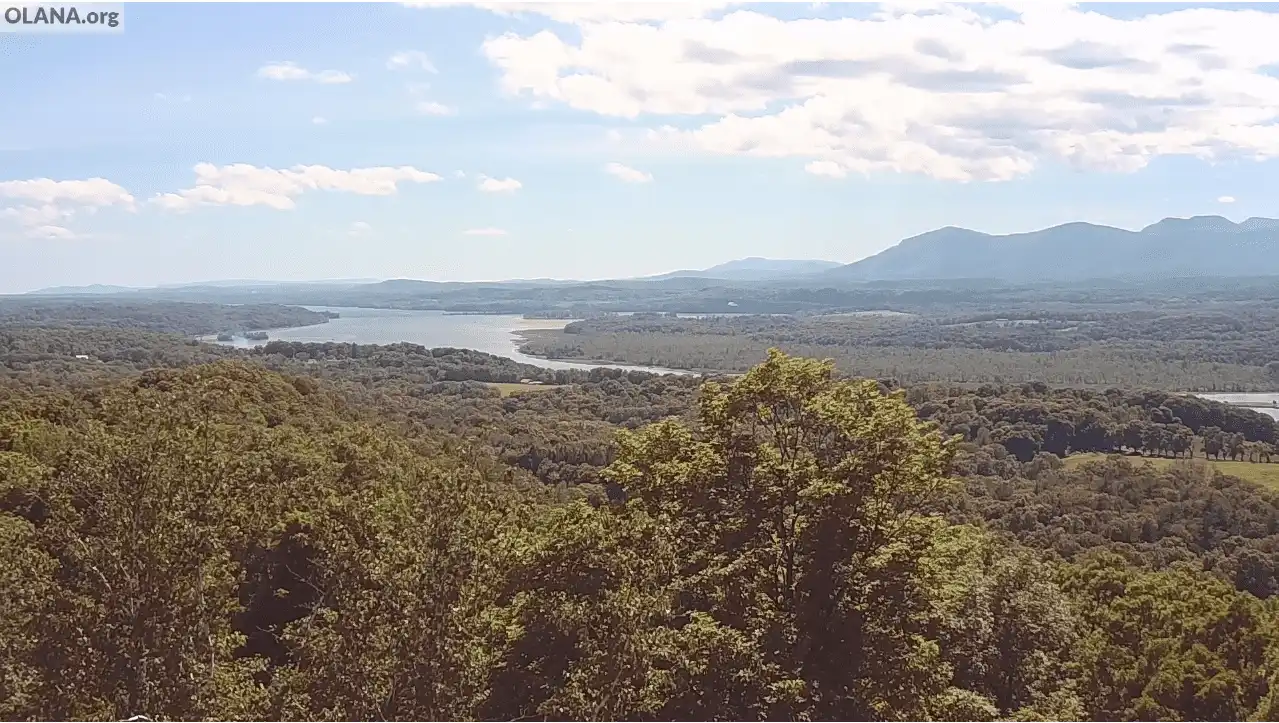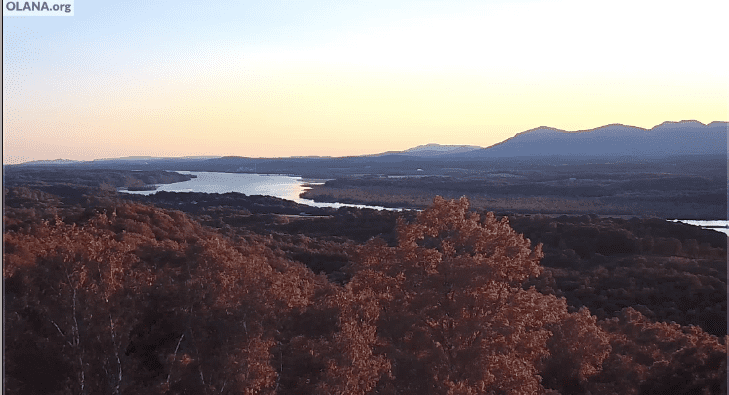Frederic Church’s New Eye on an American Landscape
by Annik LaFarge

Daytime view from the “Olana Eye”
Of course we’ll never know, but I think Frederic Church would be enchanted by the “Olana Eye,” a livestreaming camera fixed to a stanchion outside his studio by custodians of the Hudson Valley home, and landscape, he created in the 19th century. Hour by hour, day by day, the “SkyCam” offers up a new type of immersive experience that carries forward an artistic tradition Church himself helped pioneer.
Church was a teenager when photography was invented, and even as he developed his skills as a painter using oils on canvas, the new art fascinated him. He collected thousands of daguerreotypes and albumen prints, and in his library was a seminal work introducing the new art: William Henry Thornwaite’s A Guide to Photography, first published in 1845. Like his fellow Romantics, Church was preoccupied with the practice of observation and measurement, and was greatly inspired by naturalist Alexander Von Humboldt, who undertook an unprecedented, holistic study of the scientific forces – in botany, geology, meteorology, hydrology, geography, climatology, chemistry – that shape the natural world. Humboldt believed that a “profound appreciation of nature…leads us into another and higher sphere of ideas,” and that it was artists – and specifically landscape painters – who could most faithfully open this imaginative door to the masses. Church, inspired by this humanizing call to undertake scientific observation in the service of fine art, traveled in Humboldt’s footsteps across South America, and throughout his remarkable career imbued his paintings with both realism and poetry. His large-scale works toured the country, and like a modern rock band drew huge crowds. For the 1857 Niagara, he used an unconventional format – the painting is twice as wide as it is high – to convey a panoramic expanse, and the effect was thrilling. In one city after another people lined up to pay an admission fee of 25 cents to immerse themselves in this as-yet unknown corner of their country. Mark Twain visited multiple times, and even brought opera glasses so he could better examine the miraculous details in the landscape.
But what Church and his fellow artists did that was most transformative was introduce a young nation to its homeland: the look, feel, and diversity of the American place. In an era before the widespread availability of photographs and tourism, these painters portrayed the physical qualities and natural beauty of a country long considered inferior to the storied lakes, mountains, and skies of Europe. They also reflected a powerful force that was coursing through the American psyche. Just at the point when wilderness had been conquered and an industrial revolution was firing the pistons of a burgeoning economy, a new generation of young artists and writers looked around and saw a sacred, “sublime,” landscape being laid to waste. They saw in the loss of wildness to rampant industry and urbanization a massive cost on both a human and cultural scale.
Successful as Church was – and he was arguably the most famous and financially successful American painter of his generation – he considered his best work of art to be the landscape he created at Olana. In the 1880s, suffering from severe arthritis, Church turned away from his canvases to the 327 acres he owned on a prominent elevation overlooking the Hudson River, and began crafting a space of wonder and beauty for the benefit of his family, friends, and visitors. Having built his artistic career on the immersive, touring panoramas that were all the rage in 19th century America, he now treated the landscape itself as a canvas. “I have made about one and three-quarter miles of road this season,” he wrote in an 1884 letter, “opening entirely new and beautiful views. I can make more and better landscapes in this way than by tampering with canvas and paint in the Studio.” When he was done, Church had created 7 ½ miles of roads, which he conceived as pathways through a series of different landscapes that offer strikingly diverse views: woodlands, meadows, lake; a working farm with barns, orchards, vegetable gardens and ice house; church spires in the town of Hudson just a few miles away; and an iconic view of the Hudson River and Catskill Mountains that’s now live-streaming on the Internet.

Sunset from the “Olana Eye”
During the pandemic I became fixated on the Olana Eye, which was installed in May 2020 on the anniversary of Church’s birth 194 years earlier. I live just a few miles from Olana, on a neighboring landmass called Mt. Merino, which was created during the same geologic event that began some 20,000 years ago. Even with the river outside my own window, I checked in with the SkyCam multiple times day, tracking changes wrought on the landscape by weather, light, climate, temperature, position of the sun, river tides – forces that Humboldt so faithfully observed and quantified. From minute to minute the picture would change, sometimes radically, because of tiny alterations in conditions, while the perspective remained perpetually, and exactly, the same: a single view from Frederic Church’s studio. The camera captured the essence of those first months of lockdown: the fact that we were fixed in place but everything was constantly changing around us.
The folks at Olana chose that perspective with great care and intention, in order to use the camera as a storytelling device. The view it’s fixed on played an important role in the early years of the modern environmental movement, when the Power Authority of New York proposed building a 1,200 megawatt water-cooled nuclear power plant on the west bank of the Hudson River. Its 450-foot stack would vent a plume of smoke that could be seen for miles, including from Olana. It’s a significant – some would say sacrosanct – view because the movement of which Church was a part, the Hudson Valley School, is considered by scholars and historians to be the first native art culture in America. The ensuing legal fight had much in common with other key battles in the environmental movement, from Yosemite to Storm King, but the difference here is it was based on, and won on, the question of aesthetics. Front-and-center in the exhibits during hearings before a panel of administrative law judges was Church’s painting of Olana in winter, which depicts a bend in the Hudson River with the Catskill Mountain range as a backdrop. This small – it measures just 8 ½” x 13” – rendering of a Hudson Valley view that Church never sold but instead placed in his own home was, in the end, the powerful monolith that stopped a nuclear power plant. Never before had such a project had been denied a construction permit for aesthetic reasons. It is also thought to be the first time in American history that a landscape painting was used as the defining force in a legal proceeding, when aesthetics – both the beauty of the view and its cultural value – would predominate over more traditional issues in conservation battles like the protection of species, habitats, or quality of air and water.
Thornwaite’s influential Guide to Photography, the 11th edition of which Church owned, opens with a definition: “The art of making pictures by the agency of light may be designated under the general term Photography — a term derived from the two Greek words phos, ‘light,’ and graphs, ‘I write or delineate….’” In other words: I tell a story with light. It took less than a century for this notion to become cliché; the phrase “a picture is worth a thousand words” first appeared in an American trade magazine in 1921. What Church and his fellow Romantics understood was that landscape itself tells a story – about nature, culture, even national identity. Church’s paintings of the “bend in the river” are a first chapter, recalling an artist who treated the landscape as a canvas and created a living panorama that thousands of people walk through each year. The SkyCam picks up the story, using a modern camera and an Internet connection to continue and develop the narrative.
Annik LaFarge is a writer, editor, and photographer, author of the books Chasing Chopin: A Musical Journey Across Three Centuries, Four Countries, and a Half-Dozen Revolutions, and On the High Line: Exploring America’s Most Original Urban Park. Since 2009 she has written a blog about the High Line and other urban greenways around the world, LivinTheHighLine.com

